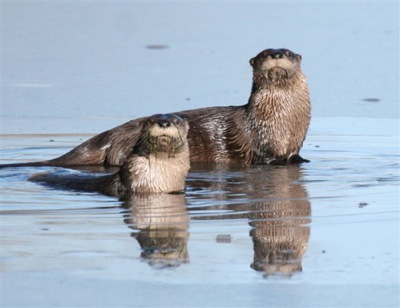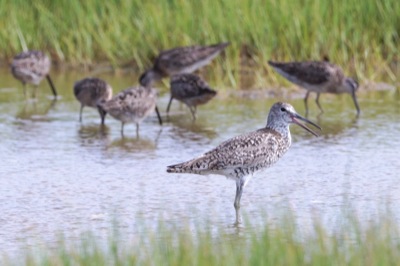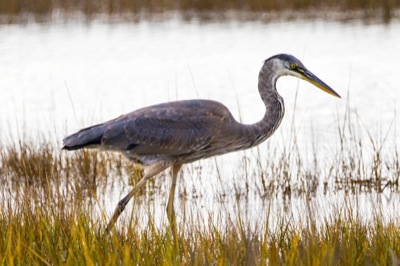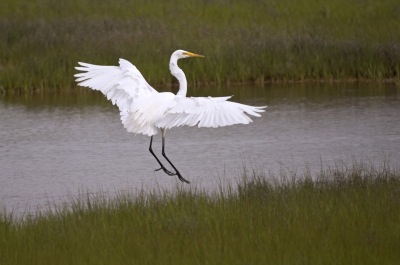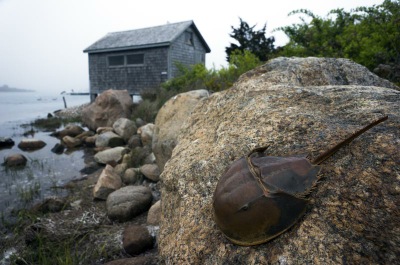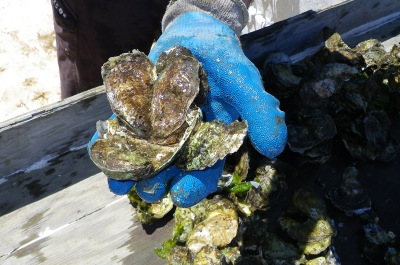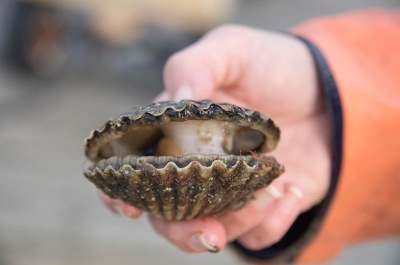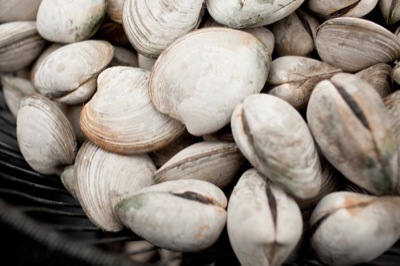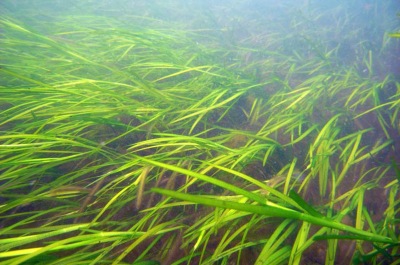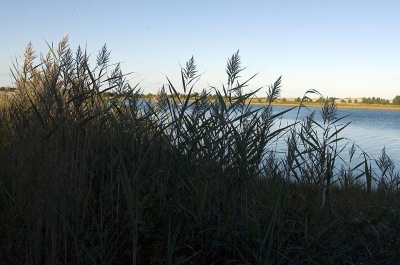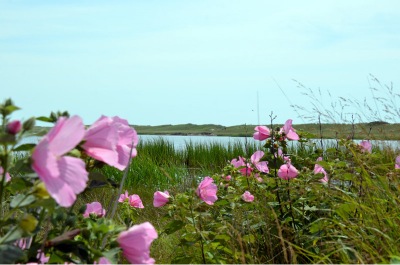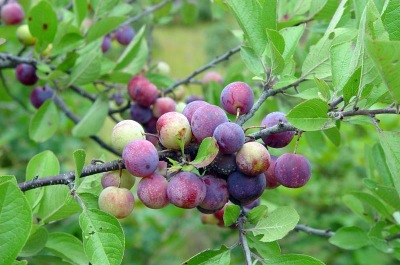River Otter
Lontra canadensis
These nocturnal animals are elusive inhabitants of Island ponds. They are strong swimmers with sleek brown fur and long tails, and are graceful and playful. During the winter they can be traced by their telltale otter slides, while in the summer months they are harder to spot. Top carnivores at Island ponds, otters eat small fish and shellfish, although they are known to have a wide diet. Island biologists have said that the degradation of ponds, which affects the fish population, has affected otters, forcing them to search elsewhere for food.
Willet
Tringa semipalmatus
A member of the sandpiper family, willets can be seen at the tidal edges of Island ponds. The birds are common summer residents, known to breed at some Island ponds, and they wade for food including insects, crustaceans, marine worms and some plants. Island biologists have been studying willets, including putting geolocators on some of the birds to track where they go when they migrate from the Vineyard. Listen for their territorial squawk, “pill-will-willet” at the edge of Island ponds, including at Sengekontacket.
Great Blue Heron
Ardea herodias
Great blue herons frequent salt marshes and pond shores as they slowly hunt for fish and other animals. The largest, heaviest heron species, the great blue is usually nearly four feet tall, with gray-blue plumage, a yellow bill and gray legs. The heron’s wingspan is up to six feet wide, and it often calls while in flight. Other herons, most commonly black-crowned night herons and green herons, can be seen in the ponds as well.
Egret
Ardea alba (great egret)
Egretta thula (snowy egret)
A few egret species can be spotted in Vineyard ponds, most commonly great egrets and snowy egrets. Both migrate to the Island for the summer and are often found on the edge of ponds or in salt marshes looking for fish. Great egrets can be more than three feet tall, long-necked and slender, with yellow bills and blackish legs. Snowy egrets are smaller, about two feet tall, with shorter necks, darker bills, and yellow feet.
Horseshoe Crab
Limulus polyphemus
A living fossil and one of the oldest species in the world, horseshoe crabs have been around for more than 300 million years. They have a hard exoskeleton with 10 legs underneath, and nine eyes scattered around their body. A long, pointed tail is used to right themselves if they are flipped over. During new and full moons in the summer months, horseshoe crabs gather on shorelines of ponds and beaches to breed. Females dig nests and lay eggs, and the males in turn fertilize them. They can live up to 20 years. Horseshoe crabs are often harvested to be used for conch bait. They are also prized for important medical reasons; their blood is used to detect impurities in drugs and medical supplies.
Eastern Oyster
Crassostrea virginica
Bivalve mollusks that grow up to 10 inches in length, Eastern oysters can be found both wild and cultivated, especially in Katama Bay and in the Great Ponds along the south shore. Farmed oysters are part of a rising aquaculture industry on the Vineyard. Besides being prized for the table, oysters are have a positive effect on pond health, naturally filtering nitrogen out of the water. One oyster can filter up to 50 gallons of water per day.
Farmed oysters are grown in cages in tidal saltwater estuaries. In the wild they grow in flats or reefs, providing shorelines with protection against erosion.
Bay Scallop
Argopecten irradians
Once abundant from Long Island to Cape Cod and the Islands, bay scallops are sensitive to pollution, over harvesting and habitat loss and now thrive only in a handful of places, including the Vineyard, Nantucket and Chatham. Prized for their sweet flavor and small size, bay scallops live in tidal saltwater ponds. The scallops have a two-year-life cycle and at maturity are about three inches in diameter, with bright blue eyes along the edge of the shells which allow them to see movement and detect predators. Juvenile bay scallops attach to plants, namely eelgrass, by a filament called a byssal thread, which protects them from bottom-feeding predators. As they grow older, the scallops drop to the pond floor and move to tidal flats to feed at high tide. Cape Pogue Pond, Sengekontacket, Lagoon Pond and Menemsha Pond all have bay scallop beds. In the fall and winter months Islanders still harvest the scallops both commercially and for family use.
Quahaug
Mercenaria mercenaria
The quahaug is a hardshell clam and bivalve mollusk native to the Vineyard, long a food source and rich in minerals and protein. Indian tribes prized quahaug shells for making wampum, used for money and other purposes. Today the distinctive purple and white shells are found in jewelry and artwork. Quahaugs range from one to four inches in size, and move about on sandy pond bottoms using a muscular foot. They are filter feeders, absorbing pollutants and bacteria and removing them from the water. They are harvested by recreational and commercial fishermen and occur primarily in tidal saltwater ponds such as Cape Pogue, Sengekontacket, the Lagoon, Tashmoo and Menemsha.
Eelgrass
Zostera marina
Considered one of the main indicators of coastal pond health. A vascular sea plant, eelgrass flowers, pollinates and produces seeds, just like its counterparts on land. Large patches are called meadows or forests. The thin plant stalks play important roles in coastal waters, providing protection for young bay scallops and herring, protecting ponds against erosion, and sequestering carbon. Eelgrass also requires sunlight to photosynthesize, which means it thrives in clean, clear water. Algae produced from excessive nitrogen is a threat, and several Island ponds have seen significant reductions in eelgrass.
Phragmites
Phragmites australis
Common reeds that grow up to 12 feet high, phragmites are one of the most widespread invasive wetland plants in the United States. The aggressive grass with fluffy seed heads often forms dense, large stands and displaces native flora and fauna. Phragmites produce by seed and via underground rhizomes, making them especially difficult to eliminate. The use of herbicides to eliminate the plant has been controversial on the Vineyard. Preliminary study by the Martha’s Vineyard Shellfish Group shows that the plant may have some value by taking up nitrogen from ponds, although more study is needed.
Rose Mallow
Hibiscus moscheutos
Sometimes called swamp rose mallow, this perennial wetland plant grows in large colonies, flowering in mid to late summer. Colors range from white to deep rose, and the inner flower is often a maroon color. A member of the hibiscus family, it is valuable to birds and other nectar feeders.
Beach Plum
Prunus maritima
A plum species native to the East Coast, beach plums grow in natural sand dune and salt-blasted habitat. The woody shrub-like plant has white flowers that bloom in May and June; in August and September, the purple stone fruit is often harvested to make jam or jelly. The hardy shrub clings to dunes like a ground cover and is effective in controlling coastal erosion.
